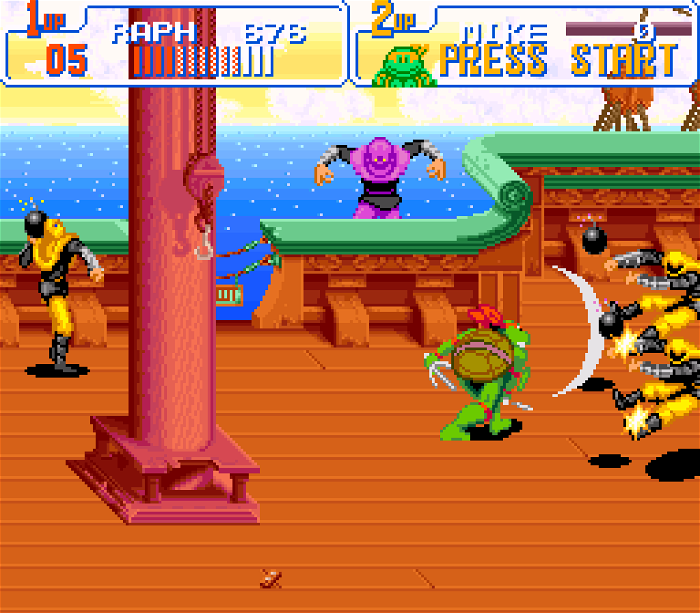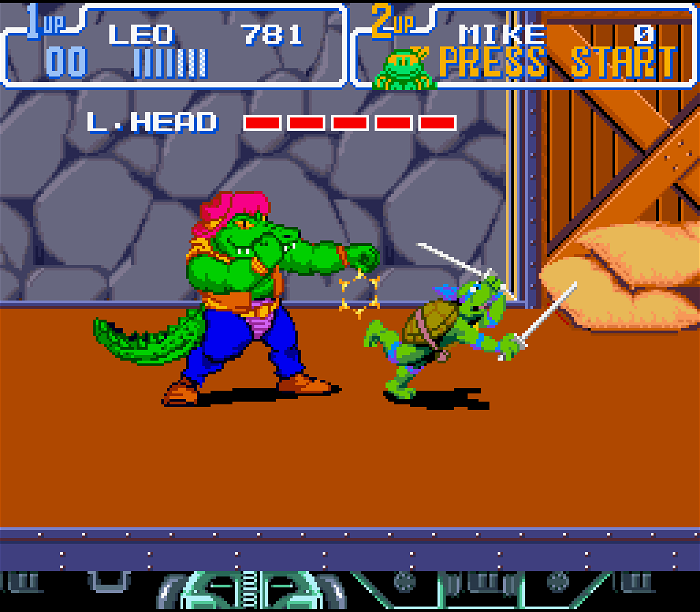In the early 1990’s, cartoon tie-in games weren’t known for their quality. Both the arcades and home consoles were awash in an ocean of mediocre licensed titles made to drive up profits of a brand instead of creating lasting memories with good products. Actually, that pretty much describes licensed games these days too, but I digress.
The point is; there wasn’t much of a lasting audience for a Saturday morning cartoon-based games beyond the initial burst of kids excited to interact with their favorite characters. Despite the occasional gem like DuckTales, licensed titles were designed as forgettable games you bought or rented for the weekend. By proxy, it’s safe to say there wasn’t much cause for excitement over a Teenage Mutant Ninja Turtles game.
Yet over two decades later, Teenage Mutant Ninja Turtles IV: Turtles in Time remains one of the most enduring titles of the 16-bit era. To this day, it’s still a much-played, much-loved game to both casual and hardcore fans alike. So what exactly makes it so much different, not to mention so much better, than its peers of the time?
“Let’s Do The Time Warp”
Like the title suggests, Turtles in Time is a game where the infamous Shredder flings our beloved quartet of talking turtles into a time warp and steals a national monument. You wouldn’t know that by the first few levels, however. From the outset, it looks like more of the same dirty streets, dingy sewers, and futuristic bases. That’s before a rift in time and space tears open, and the turtles go back to the Stone Age. From there, players have to fight their way back through history to the future, and eventually their own time, to take down Shredder and reclaim the stolen Statue of Liberty.
It’s a ridiculous premise, but one that I’d argue adds to its accessibility and appeal. See, the idea of “let’s go in a linear path in bland cityscapes and stop a bad guy” is pretty worn, especially by today’s standards. But fighting dinosaurs, cowboys, pirates, and robots through time to get back a huge American landmark is gonzo, and over-the-top in the best sort of way. The writers took the most ridiculous idea and just ran with it, but it works. Any sort of player, child or adult, casual or hardcore, can engage in something that’s so willingly campy and silly.

“Pick Up and Play”
Adding to the accessible and fun story, Turtles in Time houses some of the most simple, clean, and intuitive gameplay of its time. A side scrolling beat ‘em up at heart; Konami’s game lacks both the teeth-grinding difficulty and repetition that often plagues that genre.
For one thing, it’s not a particularly hard game to jump into and improve in, especially on the “Easy” and “Normal” difficulty levels in the home version. There’s basically just an attack button and a jump button. Throw those in some combination of those buttons with the directional pad, and you’ll get some pretty cool modified moves as well. Whether or not you’re a gaming regular, you can get the hang of the controls in a matter of a level or two. Coupled with the overall accessible difficulty, this makes Turtles in Time an ideal title for people who want to team up with their non-gaming friends for some co-op fun.
That solid core is also supplemented by a surprising amount of variety in terms of game types. The standard “clear the screen and go right” gameplay is the bread and butter of Turtles in Time, yes. But the clever boss stage gimmicks, bonus stages, and level alterations truly make it shine. One level sends players surfing through a sewer pipe, beating Foot Clan soldiers off of hover boards while dodging obstacles. Another takes the turtles on a long elevator ride to fight Shredder, who ends up in the foreground, meaning players have to throw grunts at the screen to take him out. While some of these gimmicks sound familiar to Battletoads fans, they’re still novel, and the core gameplay of Turtles in Time is infinitely more friendly.

The varied, and accessible co-operative gameplay is what sets Turtles in Time apart from other games of its era, and even from others today. It’s a great title to pick up with some friends and burn through, without having to stop every five seconds and explain the controls.
“Take Me Home Tonight”
Maybe the most key aspect to Turtles in Time’s lasting appeal lies not in its fun story or accessibility, but in how easy it was for players to get their hands on it in the 90’s. At this point, arcade games were leaps and bounds ahead of consoles. This was a few years before the tides turned and consoles made arcades look less and less appealing to the casual consumer. Because of this, it’s fair to say that, outside of some exceptional examples, most ports of arcade games just didn’t compare to their original versions. Content was altered, trimmed, and oftentimes outright cut to squeeze games onto 16-bit carts. While graphically, a lot was changed between the arcade and home versions of Turtles in Time, the home version is arguably the better product.
For starters, there are a multitude of options available compared to other home games on the market. On top of the ability to outright change the difficulty and amount of lives, which many games left out, players can change the game’s art style to an extent. In the options menu of the home version, players can change the “Color Mode” between “Comic” and “Animation.” The former gives the turtles a darker color scheme more in line with the original indie comics, and the latter is a brighter palette for those accustomed to the cartoon. It may seem like a small touch, and it is, but it’s nice that it’s there.

That’s not even mentioning the superior rearrangement of levels and bosses in the home version, on top of the entirely new stages in the game. Yes, instead of cutting content in the transition to home consoles, Konami actually added new stuff, and finished levels that weren’t ready in time to ship with the arcade game. It’s a longer, more substantial, and better put-together game on the SNES.
This is something that was huge at the time. A console release with stellar co-op that was somehow better than the arcade version was practically unheard of. It left room for renting it for the weekend for a sleepover, or adding to your collection for whenever a friend hung out, without the fear of playing an inferior game. It set a precedent for good home ports of arcade co-op games, because it upped the ante of what was expected.
“Shell Yeah!”
Teenage Mutant Ninja Turtles IV: Turtles in Time is, to this day, an astonishing piece of work. The arcade version is excellent in its own right, but its home release earned it a place in the hearts of millions of kids around the world. It’s an accessible, varied, and dynamic experience that holds up over twenty years later. Konami’s stellar beat ‘em up showed us that home releases didn’t have to be pared-down, and that licensed games didn’t have to be disposable garbage made to turn a quick profit.
Its accessibility, replayability, and slew of features make it one of the most significant releases of its era, and earns it a place among the greatest beat-em-up and cooperative games of all time.




